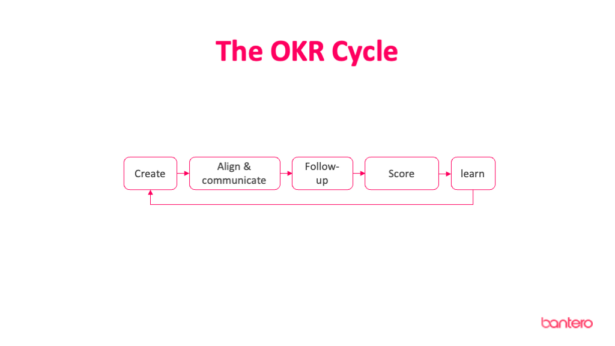Get started with OKRs
We are happy to offer 30 minutes of free OKR coaching to set you on track for your implementation!
Schedule 30m introIn its essence, OKR is a tool for strategy execution. It is a management device to formulate clearly understandable goals in the organisation and have all members of the organisation align towards them. This wouldn’t be possible without a defined cycle for setting, following up on and learning from these goals.
OKR dual cadence

In most OKR implementations, a dual cadence of strategic and team OKRs is employed. The strategic OKRs usually run by the year while team OKRs are revisited every quarter (or forth month). This way the organisation keeps a longer term strategic outlook and direction while teams work on goals that are small enough to be improved upon in just a quarter.
An OKR cycle consists of creating the OKRs, aligning them horizontally and vertically, communicating them to the organisation, following up on them (weekly or bi-weekly for team OKRs, at least monthly for strategic OKRs), scoring the results and performing a retrospective on the cycle.
The OKR Cycle

The OKR cycle looks the same for team OKRs and organisation OKRs, with the difference being what goes into the creation of OKRs, differences in alignment for team and organisation OKRs as well as a much larger emphasis on communication of OKRs from the organisation than individual teams.
- Create – the OKR cycle starts with the creation of OKRs for the cycle. If it is the first OKR cycle for the team or organisation, work will begin from a clean slate, but for all subsequent OKR creations there is usually some OKRs to be carried forward from the previous cycle. Learn more about team OKRs here and strategic / organisation OKRs here
- Align & Communicate – part of the creation process of OKRs is the alignment needed before the OKRs can be considered for publishing. Alignment is vertical (from team to organisation OKRs) and horisontal (sorting out dependencies between teams). OKRs are broadly communicated on the strategic level while the team OKRs are usually just published for access by anyone in the organisation and distributed to teams with dependencies.
- Follow-up / check-in – team OKRs should be followed-up at least bi-weekly but in most cases weekly. It is beneficial if this follow-up is embedded in the teams regular weekly check-ins. Goal of a check-in is to have the current key results performance updated as well as to assign each key result a traffic light status (to indicate if it is on track). Discussion should focus on what initiatives and activities are activated to ensure key results come on or stay on track.
- Score – at the end of the cycle, all OKRs are scored with a method of choice (common to use traffic lights here as well, but scoring each key result 0-1 is also popular). The point of scoring is to establish a common understanding before the retrospective that will impact how OKRs are set for the next cycle.
- Retrospective – this is an open team discussion on the OKRs as well as the work itself. Why did we reach this score, what OKRs worked well to drive activity, did we have struggles with the process and can we pick up any learnings for the next cycle are common questions for discussion here.
It is very common for teams to need a couple of cycles to really get up to speed on OKRs. Each retrospective has the purpose of aligning the team closer towards an adaption of OKRs that fits the culture and focus of the particular team. As the team learns together, a greater amount of autonomy and ownership of the goals can often be established.
/6 completed Getting started articles
Get started with OKRs
We are happy to offer 30 minutes of free OKR coaching to set you on track for your implementation!
Schedule 30m intro